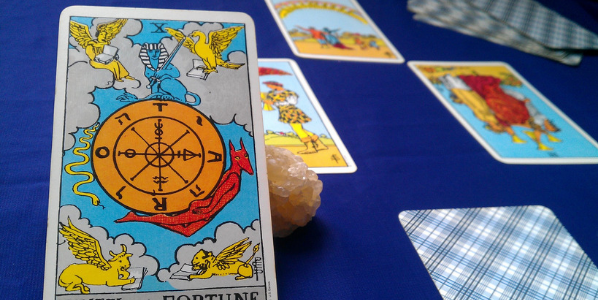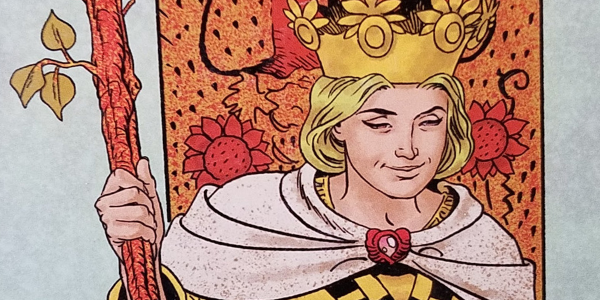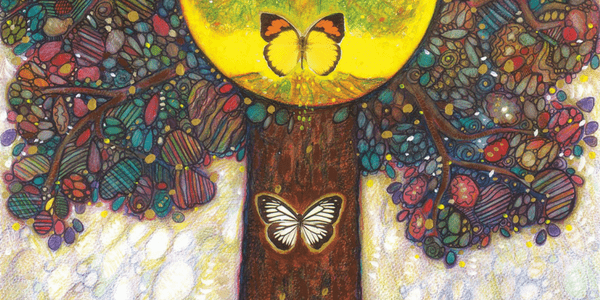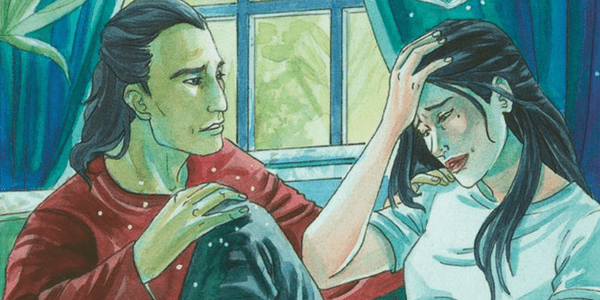
On some level, everyone is familiar with the tarot; from occultists, witches, and Pagans — even people who have no links to or interest in the occult. These intricate cards have become a part of mainstream culture, featuring in everything from fashion to film and literature, and yet for those of us who feel an affinity to the cards, they are so much more.
Learning the tarot is not for those unwilling to make the effort. Nothing worth doing in life is easy, and this is true of learning the tarot as well.
These are cards of journey. We use them to plot our way through life and seek answers for decisions yet made. As a result, learning of their wisdom is a journey all in itself. Working with the tarot requires a serious effort. It is time consuming and ever ongoing; I don’t think you ever stop learning with the tarot. Like I said, it’s a journey.
So, where to start?
There are so many books on the market, and most decks come with a little booklet explaining the general meaning of the cards. However, the problem in using just books alone means that much of the information is secondhand.
I firmly believe people learn best from doing, though that does not mean the books are not helpful, indeed they are, and so with that, let me share with you, fellow seeker, some of the hints and tips that have helped me in my own journey with the tarot.
Related: How to buy a tarot deck, by Donyae Coles
Related: Tarot for kids: 15 decks to get them started, by Donyae Coles
Related: Find your new favourite indie tarot among these 11 decks, by Daleth West

Reviewed: Before Tarot, reviewed by Tammy Hanley
Reviewed: After Tarot, reviewed by Psyche
Exercise: Study one tarot card each day
I know, I know, there are so many cards — 78 to be exact!
This task may sound daunting at first. I know, I’ve been there. I’ve thought ”it’s just too much time, too long” or ”it’s too big a job,” and have given up. But then the months pass, and you realize that you’d be finished already and then you feel, well, disappointed. And that’s ok, so long as you use that disappointment to motivate yourself.
So, what does this exercise actually involve?
Start with the major arcana — with the Fool — and work through in order. Take enough time each day to spend studying the card. How long? Twenty minutes should be plenty of time.
Spend a couple of minutes in meditation or just breathing.
When you are ready, take the card. Just look at it. Take in the imagery. Are there people or animals in the card, and, if so, what are they doing? What colours are dominant? What does the imagery depict? What is your initial reaction to the card? What feelings does it arouse within you?
Make any notes you need in a notebook or journal.
Now turn to the accompanying booklet or any reference book or website. How do your observations relate to the traditional meanings within the book? Are there similarities? Are there any differences? If so, spend some time exploring how you feel.
It’s important to remember that there are no wrong or right answers here, and that what matters is that you get used to reading the imagery contained within the card and interpreting it based on the symbols and how they make you think and feel. It helps to keep in mind that everything contained in the card is there for a purpose, so pay attention to even minute details.
Though this exercise is time consuming, it gives you the time and space to build a personal relationship with each and every card.
Related: Why you should keep a magical journal, by Michael Reese
Related: How to read inverted tarot cards, by Jarred Triskelion

Reviewed: Art of Love Tarot, reviewed by Anna Kali
Exercise: Read one tarot card each day
The above exercise, as already mentioned, is extremely good for getting to grips with each card, but when you first begin on your own tarot journey, and certainly when you are already well established, you just want to do more. And this is where this everyday exercises come in useful.
Shuffle the cards and split the deck however works for you. As you are shuffling, think about what it is you want the card to represent. The message can either be an overview for the day, or perhaps a representation of some quality you possess that will see you through. You decide the message from the card. I usually utter something along the lines of “what will the day present to me?” as I’m shuffling. However, feel free to ask what you want.

Reviewed: Next World Tarot, reviewed by Donyae Coles
Exercise: A daily three-card spread
When you wish to progress further, a three-card spread is ideal and a good way of incorporating the tarot into your everyday practice. Like the single card method, this daily spread still gives an overview of the day but in more detail. The first card represents any issues that may arise; the second represents you, and the traits you possess that will help you; and and the third card is the outcome.
This method gets you used to reading in-between the cards. That is, it has you make connections between the cards and reveals the deeper meaning of the spread. Again, you don’t need to spend too long and it shouldn’t take longer than 20 minutes.
It’s also a good idea to keep a journal of how you develop with the tarot. When you read back on your progress, not only does it show you of how far you’ve come, but it often serves to remind you of insights that you may have perhaps forgotten. If nothing else, keeping a journal is a good way to work out any frustrations you may be having, all of which helps deepen your understanding of the tarot.
Related: Crafting a tarot wreath, by Tabitha Dial
Related: Epistolary tarot: Love, letting go, and learning, by Marjorie Jensen

Reviewed: Celtic Tarot, reviewed by Corinna Underwood
Read tarot cards as a whole and tell a story
So we’ve looked at the cards as single items, and we’ve also explored branching off from the single-card reading. Let’s look now at the tarot as a whole, and how the cards relate to one another.
The major arcana can be said to tell the story of human archetypes, the universal human struggles. We begin at zero with the Fool, and pass through all of the other cards on a journey of self discovery and self mastery, until you get to the end, The World.
A good way of understanding the journey of the major arcana is to lay the cards out in order and to look at them as though telling a story. In your notebook, write how the fool progresses along their journey, blind to the dangers that may beset them, but with an air for discovery. How they becomes the Magician, picking up experience and the tools of transformation. They then pass through each stage depicted in the cards, learning lessons until they gets to the end, where the world is their oyster: full of possibility.
This allows you to explore each card individually, but also helps to develop your skills and you can see how the cards connect to one another as a whole.
You can do the same thing with each of the different suits (cups, wands, swords, and pentacles) as well.
Whereas the major arcana deals with the overarching human struggles, of self-discovery and transformation, the minor arcana deals with the everyday matters of life.
With the suits, each one has it’s own correspondences and so these will feature within the narrative. For example, the cup suit tells the story of relationships and emotions; wands are fiery and so deals with passions and inspirations — things that get you fired up, such as lust; swords deal with conflict and how you deal with that conflict when it arises; and pentacles are mundane, earthly matters, think work, home, health.
The cards go from one to 10, and then there are the court cards, usually the page, the knight, the king, and the queen, or some variant.
For me, the cards one to 10 refer to the journey through the suit. So you start at the ace — the card of possibility, of adventure — and then proceed through the journey — the good times and the bad — until you reach your journey’s end at the 10.
The court cards then are the things you take from that journey. So, the page represents your thoughts and impressions of the journey. The knights are the actions cards, and so represent how the journey has affected you, and how it might influence any further actions. The queen is the emotional understanding of the journey. Finally, the king represents completion of the physical and the emotional, reconciled into one complete understanding.
As with the major arcana, for each suit, lay the cards out in order and read the story of the cards, making any notes you feel relevant in your journal.
Related: Tarot beyond fortune telling, by Marjorie Jensen
Related: Tarot court cards as creative archetypes, by Tabitha Dial

Review: Book of Shadows Tarot Complete Kit, reviewed by Donyae Coles
Tips to keep yourself going
If you miss a day, or even two or three, don’t beat yourself up and tell yourself you might as well stop. Just carry on where you left off. It’s not a big deal, only a blip.
Don’t get frustrated when you feel like you just can’t read a particular card. Instead, view this as an opportunity to dig a bit deeper into the meaning of that card.
If you’ve got friends who also dabble in the tarot, organize a get together where you pull cards for each other. Just have fun, relax and enjoy it. These sessions are really good for getting new and different perspectives, as well as bouncing ideas off other like-minded folks.
Related: Learning from failure: Turning lead into gold, by Chrysanthemum White Alder
Related: Tarot and oracle cards together: Add depth and complexity to your readings, by Donyae Coles
All of the hints and tips contained herein I have personally used in my own craft, and I have found them particularly useful, and I share them here in the hope they might help you too. Take what works for you, and discard the rest.
The most important tip, though, is to enjoy your journey with the tarot, as it as much about understanding yourself as well as the cards.
Image credit: Numerology Sign








